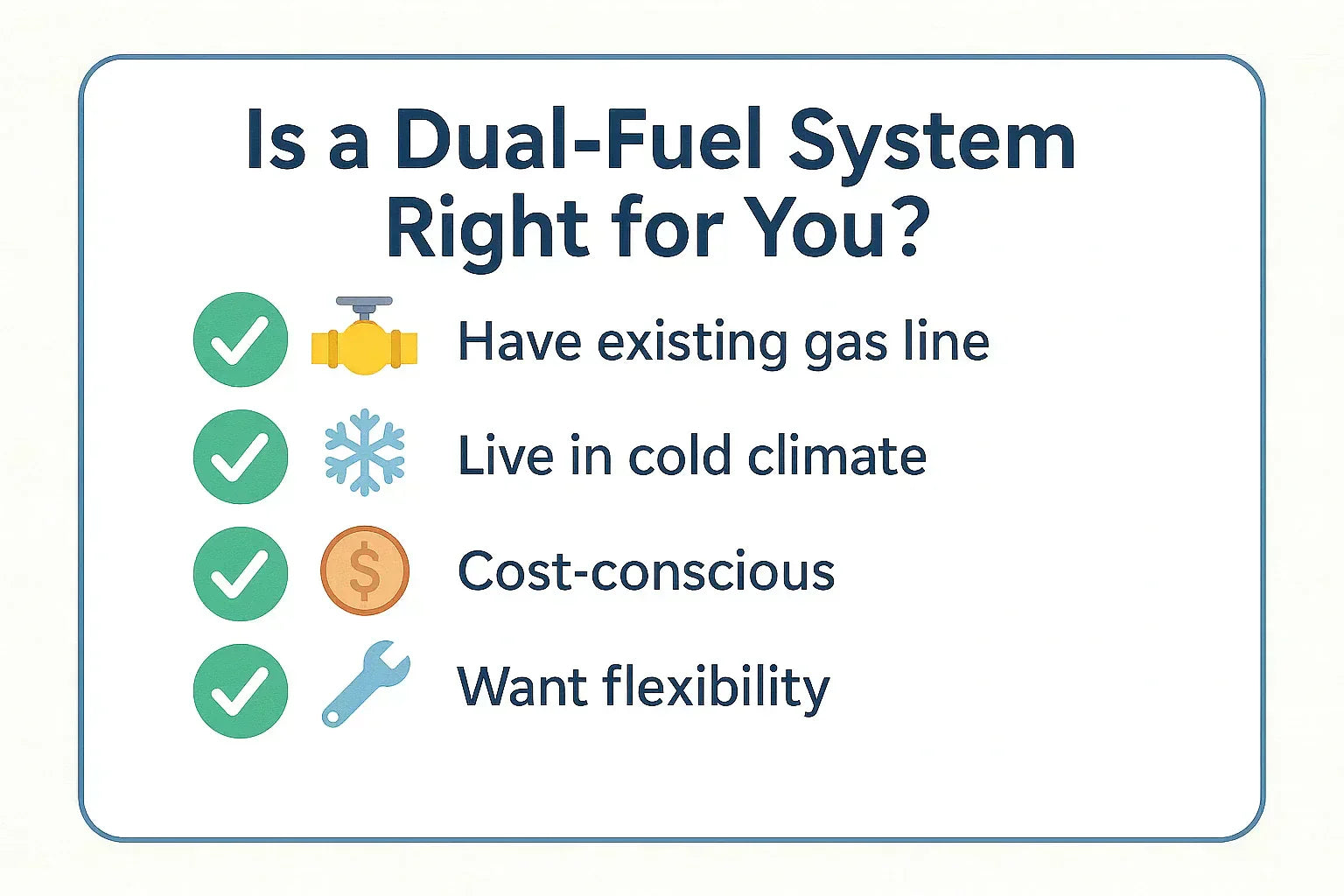If you live in a region where winters drop well below freezing, you might love the idea of an energy-efficient heat pump—but worry it won’t keep you warm when temperatures really tank. That’s where dual-fuel systems come in.
A dual-fuel system gives you the best of both worlds: a high-efficiency heat pump for mild to moderately cold days, and a gas furnace backup for when the mercury drops. It’s a popular choice for homeowners in cold climates who want efficiency, comfort, and peace of mind—all in one system.
In this guide, I’ll break down how dual-fuel systems work, who they’re right for, and why they’re one of the smartest heating options in 2025.
What Is a Dual-Fuel System?
A dual-fuel HVAC system pairs an electric heat pump with a gas furnace. Instead of relying on electric resistance strips for backup (which are costly and inefficient), the system switches to the gas furnace only when outdoor temperatures are too low for the heat pump to work efficiently.
Here’s the basic logic:
-
The heat pump handles most of your home’s heating load when temperatures are above 30–35°F
-
When temps drop below that threshold, the gas furnace kicks in
-
A smart thermostat or control board automatically switches between the two systems based on outdoor temperature
📘 Lennox explains the benefits of dual-fuel heat pump systems here
How It Works in Cold Weather
Cold climate heat pumps (CCHPs) work well down to 0°F or even -13°F depending on the model—but they can lose capacity and efficiency at those extremes. That’s where the furnace takes over.
Typical Heat Source by Temperature Range
-
40°F to 30°F+ → Heat pump only
-
30°F to ~15°F → Heat pump runs at partial capacity
-
Below ~15°F → System switches to gas furnace
Because the system only uses gas when absolutely necessary, your fuel consumption and emissions are lower than with a traditional furnace-only setup.
Key Benefits of Dual-Fuel Heating
1. Efficiency and Lower Energy Bills
A heat pump is more efficient than a furnace in moderate weather. It transfers heat rather than generating it, which cuts energy use and utility bills.
In most regions, the heat pump will handle 60–80% of the heating season, reducing your dependence on natural gas or propane.
2. Cold-Weather Confidence
When the forecast calls for subzero temperatures, you’re still covered. The furnace kicks in seamlessly, ensuring reliable heat even during polar vortex-level events.
3. Lower Carbon Footprint
By using electricity when it makes sense and gas only when necessary, dual-fuel systems are a smart choice for emissions reduction—especially in homes with a clean energy mix.
📘 The U.S. DOE’s Better Buildings project demonstrates how hybrid systems can reduce fossil fuel use while maintaining comfort.
When a Dual-Fuel System Makes Sense
Dual-fuel isn’t the right choice for everyone, but it’s a great fit if:
-
You live in a cold climate and want to reduce gas use without sacrificing comfort
-
You have existing ductwork and a gas line, which lowers installation cost
-
You’re interested in electrification, but not ready to go 100% electric
-
You want to take advantage of utility rate swings by using the cheaper energy source day to day
📘 For more use cases, check out Trane’s guide to hybrid HVAC systems
Dual-Fuel vs. Electric Resistance Backup
Let’s clear something up: not all heat pump backups are created equal.
| Feature | Dual-Fuel (Gas) | Electric Resistance |
|---|---|---|
| Backup Source | Gas Furnace | Electric Heat Strips |
| Low-Temp Performance | High | Low |
| Energy Efficiency | Better | Poor |
| Operating Cost | Lower (natural gas) | Higher (kWh usage) |
| Output Power | Fast, strong heat | Slower, limited output |
📘 Carrier outlines the pros and cons of backup heat types
If your electric rates are high—or your winters are particularly brutal—gas backup is almost always the more cost-effective and comfortable option.
Installation & System Compatibility
What You’ll Need for a Dual-Fuel Setup
-
Compatible thermostat or control board that can switch between systems
-
A cold climate-rated heat pump, preferably inverter-driven
-
A gas furnace sized appropriately for your home’s peak heating load
-
Proper ductwork that supports both systems (existing setups can often be reused)
Most HVAC contractors can design and install a dual-fuel system using your existing gas furnace—or replace both units for a completely modern setup.
Final Thoughts from Alex Lane
Dual-fuel systems are one of my favorite solutions for homeowners in cold climates who want to transition to cleaner energy—without giving up reliability. You’ll save money during the shoulder seasons, reduce emissions overall, and stay warm when it really matters.
Here’s the short version:
✅ Use electricity when it’s efficient
✅ Use gas only when you really need it
✅ Let your system make the smart switch for you
It’s a win-win—especially when installed correctly and sized right for your climate.
👉 Want to explore other high-efficiency systems built for freezing temps? Start here: Best Heat Pumps for Cold Climates in 2025
👉 Wondering if heat pumps are noisy in winter? Read next: Noise Levels of Cold Climate Heat Pumps: What’s Normal?
Alex Lane
Your Home Comfort Advocate







